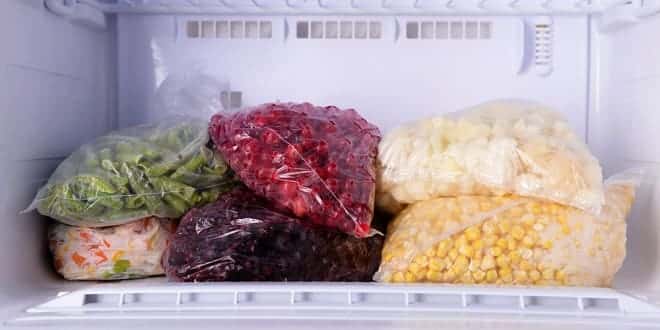Freezing Prepared Foods
Foods for packed lunches or elaborate dinners can be kept in your freezer ready for busy days, parties or unexpected company. By planning a steady flow of casseroles, main dishes, baked goods and desserts in and out of your freezer, you can make good use of your freezer and good use of your time.
ADVANTAGES OF FREEZING PREPARED FOODS
• You prepare food at your convenience.
• Your oven is used more efficiently by baking more than one dish at a time.
• You avoid waste by freezing leftovers and using them as “planned overs.”
• Special diet foods and baby foods can be prepared in quantity and frozen in single portions.
• You save time by doubling or tripling recipes and freezing the extra food.
• If you cook for one or two, individual portions of an ordinary recipe can be frozen for later use.
ON THE OTHER HAND . . .
• Freezing is expensive when you add up the cost of packaging, of energy use and of the freezer itself.
• More energy is used in cooking, freezing and reheating than in cooking from scratch and serving immediately.
• Prepared foods have a relatively short storage life in the freezer compared to the individual ingredients like frozen fruits, vegetables and meat.
• Unless you have a microwave oven to dedicate to thawing during meal preparation, you must allow plenty of time for thawing in the refrigerator.
• Some products do not freeze well. Others do not justify the labor and expense of freezing.
PREPARING TO FREEZE
If you are not sure about how a prepared food freezes, try freezing just a small portion the first time and checking to see if the quality is acceptable in 1 to 2 months or more. Foods to be frozen should be slightly undercooked if they are to be reheated after freezing. Foods should be cooled quickly for safety and freshness. Keeping foods at room temperature for several hours before freezing increases chances of spoilage and foodborne illness. Flavor, color, texture and nutrient content are likely to deteriorate also.
To speed cooling, put the pan containing hot prepared dishes—main dishes, sauces, etc.—in another pan or sink of ice water. This is especially important when preparing large amounts of food. Keep the water cold by changing it frequently or run cold water around the pan of food. When cool, package and freeze immediately. (Note: Do not place hot glass or ceramic dishes in ice water—they may break.)
PACKAGING
Pack foods in amounts you will use at one time. Once food is thawed, it spoils more quickly than when fresh. Use moisture-vapor resistant packaging. Air shortens shelf life and affects food color, flavor and texture in
undesirable ways. If you have empty space in a plastic freezer carton or other rigid container, fill it with crumpled freezer paper. Be sure to label each package with the name of the food and the date. For packaging foods, coated or laminated freezer papers, plastic wraps or bags and heavy-duty aluminum foil are good. If lightweight freezer bags are used, protect them by placing them inside rigid containers. Rigid containers that can be used for freezing foods include plastic cartons or glass jars designed for canning and freezing. Wide-mouth jars are best for freezing because their contents are easier to remove before complete thawing takes place.
Some household food containers are not suitable for freezing. The cartons that come with milk, cottage cheese, yogurt, margarine, and many other refrigerated foods are not moisture-vapor resistant enough for freezing and do not produce seals airtight enough for freezing. Narrow mouth jars can break at the neck from the pressure of
food expanding. Jars not manufactured for extreme temperature changes can break easily also. Do not reuse plastic containers and trays that come with microwavable entrées.
FREEZER STORAGE
Freeze prepared foods at 0°F or below. For quickest freezing, place the packages against the refrigerated surfaces of the freezer. Spread the warm packages out around the freezer. After the food is frozen, rearrange the packages and store frozen foods close together. Freeze only the amount of food that will freeze within 24 hours. This is usually two to three pounds of food per cubic foot of freezer space. It is a good idea to post a list of the frozen foods with freezing dates near the freezer and check the packages off the list as they are removed.
Other sources of information may list different storage times. Foods stored at 0°F longer than the storage
times listed here should be safe but may be of less acceptable quality. Foods listed in the sections below as “problem foods” are not recommended for freezing. For efficiency and a better-tasting product, these “problem foods” should be eaten soon after preparation.
…

